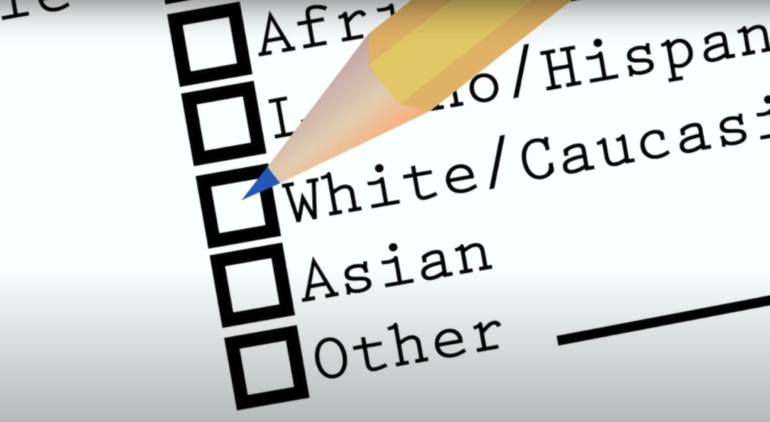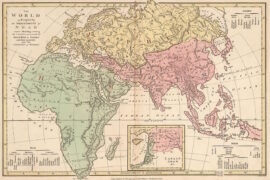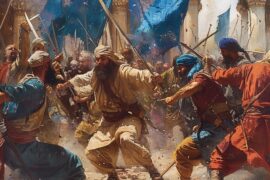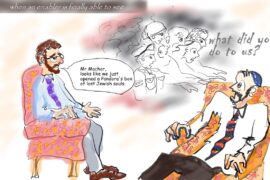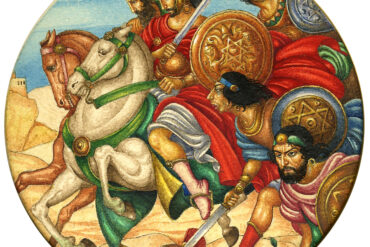The conversation surrounding Jews and whiteness is a complicated one, especially since “being white” actually means totally different things within the contexts of the vastly different experiences held by the Black and Jewish (especially Ashkenazi) communities in the United States.
For better or worse, the less assimilated a Jew is in American society today, the less likely he is to understand that the term “whiteness” largely refers to the institutionalized discrimination and oppression experienced as a result of being non-white. Examples of this include implicit biases, underfunded schools, redlining neighborhoods, predatory lending, police brutality, mandatory minimums, mass incarceration (in prisons that are actually private businesses using inmates for slave labor) and more. Since its inception, US law enforcement has prioritized white property over Black lives (who happened to have actually been white property when the United States was established) and there’s plenty of room to argue that to still be the case.
Even once slavery was legally abolished throughout the United States, Black Americans were for the most part pushed into becoming a permanently exploitable group of workers kept in line through institutional discrimination and violence – a population largely kept dependent on low wage jobs so they can serve as the shock absorbers for the economic crises inherent in the current system.
Immigrant communities and other minority groups have for the most part confronted similar institutionalized barriers that have come to define the experience of being non-white in the United States. And when a person or group of people who don’t share these experiences – or the painful insecurities and disadvantages that stem from them – protest being called white, it can be highly offensive to those victimized by whiteness.
But the fact remains that Jews, especially those deeply connected to their own people’s identity and collective story, are generally offended by being called white – not because they deny enjoying some of the privileges denied others, but because “whiteness” means something totally different within the context of the Jewish experience. So rather than argue past one another while ascribing radically different meanings to the same words, it would be helpful to define what each community actually means to say when using these terms.
In accordance with an age-old primordialist understanding of identity, many Jews tend to understand “whiteness” as describing the biological descendants of European peoples, or at least as an identification with some amorphous Anglo-Saxon narrative. What most people outside the Jewish community don’t appreciate is that within the Hebrew meta-narrative stretching back thousands of years, there actually is such a thing as white identity that’s associated in ancient rabbinic literature with the children of Yefet and descendants of Esav – a civilization built on the foundations of the Greco-Roman and Christian world views.
After being exiled from Judea following the Bar-Kokhba Revolt, Ashkenazi Jews spent centuries either suffering harsh persecution within Europe or resisting external pressures to conform to Christian beliefs and practices. Since the 18th century, there has been internal pressure within “enlightened” Jewish circles – especially in Western Europe and North America – to assimilate into Western/white civilization (to various degrees) and avoid the type of violent persecution that had defined much of Jewish history within that civilization. Within the broader Jewish meta-narrative, advocates of assimilating into the privileged majority culture have been traditionally viewed as at best selling out and, at worst, internal threats to the historic Hebrew mission as Jews have understood that mission for thousands of years.
One of the difficulties many Jews psychologically living in the Hebrew meta-narrative often have with the concept of white privilege as it’s used in the broader contemporary discourse is that it seems to isolate our current period of history and ignore dynamic patterns that often transcend generations. Among those who see a living pattern to history, especially Jewish history, there’s a strong belief that inclusion and privilege are things Jews often temporarily experience in Western societies just prior to extreme episodes of persecution (the most obvious recent example being the Jewish experience in Germany just prior to the 1930s).
Given the fact that Jewish communities generally experience an impulse to view those Jews who define themselves as “white” not only as diluting and betraying their own identities but also as succumbing to a false sense of security with potentially catastrophic results, the best we might be able to achieve under these circumstances would be to educate those Jews living in the narrative of Jewish history to understand what whiteness and white privilege mean within the contemporary discourse. But this would require creating sufficient space for these Jews to sensitize themselves to the struggles of those suffering oppression in the here and now without feeling pressure to accept a label (whiteness) perceived as antithetical to their identities and dangerous according to the lessons of their people’s history.
What might help Jews better understand how whiteness works in the United States – and where they stand in relation to it – might be asking how they think Black and Jewish residents of a mixed neighborhood might feel in the event of an increased local police presence. The fact that Black residents might feel less secure while Jewish residents would likely feel more secure demonstrates the extent to which Jews have attained whiteness in American society. The very fact that so many US Jews trust and feel protected by state institutions demonstrates the extent to which they’ve been conditioned to experience those institutions as existing for their benefit.
This isn’t to say that Jews have always enjoyed white privilege in the United States. Prior to World War II, Jews were very much excluded from whiteness and experienced much of the same discrimination and institutionalized exclusion as other immigrant and minority groups. But following WWII (and perhaps due in part to the horrors of the Holocaust), Jews were offered conditional inclusion into whiteness. Like their Italian and Irish counterparts who had previously suffered exclusion, Jews benefitted materially from the GI Bill, were accepted into previously restricted universities and granted access to the suburban American Dream.
But this Jewish inclusion into American whiteness has been conditional and has required US Jews to dilute aspects of their identities, especially ethnic and cultural distinctions that previously identified Jews as non-white. Because the very desire to fit in with host nations had directly resulted from experiences of traumatic persecution connected to Jews being perceived as non-white in European societies, the conditioned Ashkenazi drive to water down “Jewishness” in exchange for inclusion should itself be understood as one of several stages in a long process of identity colonization that began with Rome’s conquest of Judea and our subsequent exile.
Jewish “whiteness” might only exist when one contextualizes Jewish identity according to the paradigm of another people’s experiences and challenges, and the fact that Jews have had to change our names, shrink our noses, straighten our hair and betray our own culture and values in order to achieve a “privilege” defined by what others are denied is an important part of our story. So although many Jews have had the unique ability to pass and gain inclusion that other groups lack, we mustn’t forget the price that was paid and continue to be paid for this “privilege” (other groups not even having the option to pay this price doesn’t negate the damage paying it has cost the Jewish people).
It could also be argued that of all the minority populations in the United States, Jews are the only group that experiences itself as being on probation, with community leaders and institutions constantly encouraging Jews to conform to American standards of patriotism, respectability and success so as not to threaten the conditional “whiteness” Jews have attained.
But beyond even that, the post-war Jewish inclusion into American whiteness was actually the beginning of a far more problematic yet less visible system of oppression modeled off the Jewish position in Europe’s feudal system.
In Medieval times, Jews had been the shock absorbers of Europe’s class societies. Anti-Semitism developed within Europe as a strategy employed by the feudal nobility to deflect blame for systemic injustices. As tax collectors and money lenders, Jews were “middle agents” drafted into being the local representatives of a distant ruling class that exploited them while squeezing the life out of Europe’s peasant class.
According to activist-artist-historian Aurora Levins Morales, the entire point of anti-Semitism in feudal Europe had been to create a vulnerable buffer group that could be bribed with some privileges and protection into managing the exploitation of others. Jewish populations would often cooperate with the nobility because centuries of persecution made us desperate for a sense of security.
But when social pressure would build, the buffer group was blamed and scapegoated in order to distract those at the bottom from the crimes of those at the top. Peasants who initiated pogroms against their Jewish neighbors generally didn’t make it to the lord’s castle to burn him out.
The institutionalization of anti-Semitism as a feature of US capitalism has been slightly more complicated. While systemic racism is designed to ensure the failure of the Black community in disproportionately high numbers, anti-Semitism grants Jews very visible inclusion and disproportionate success in accumulating wealth and influence.
Jews are therefore positioned in such a way that actually reinforces anti-Jewish conspiracy theories and enables them to be easily scapegoated by the establishment in the event of a major crisis.
But on a smaller scale, this has forced Jews into conflict with other minority communities, who often perceive Jews as beneficiaries of the same institutions they experience as oppressive. And the more vulnerable the Jewish community feels, the more desperate it becomes for a sense of security, thereby increasing its dependency on the power structure.
My friend Benjamin Case points out in his crucial work, Decolonizing Jewishness: Jewish Liberation in the 21st Century, that Karen Brodkin – who literally wrote the book on Jews attaining whiteness in the United States (How Jews Became White Folks & What That Says About Race in America) – reversed her position on Jews becoming “white folks” in 2016. Following Donald Trump’s successful presidential campaign, Brodkin addressed the question of whether or not that campaign’s anti-Semitic tropes and the accompanying violent attacks on Jewish persons and communal sites indicate that Jews could become non-white again.
According to Brodkin, the question itself is the answer because whiteness by definition must be non-revocable. Part of its constructed social power is protection from the insecurity of losing one’s privilege. If Jewish whiteness can be revoked, Jews were never really white to begin with.
Gaining conditional admittance into the club isn’t comparable to being on the committee that grants admittance. In many Diasporas over the centuries, periods where Jews enjoyed the illusions of privilege and belonging were often followed up by harsh – and in some cases catastrophic – wake-up calls. The fact that the US Jewish community experiences its inclusion into American whiteness as probationary and the fact that Ashkenazi Jews in particular live with a deep sense of vulnerability and constant angst over the historical pattern of anti-Jewish persecution potentially repeating itself (with constant indications that it might) shows that Jews are in fact not actually white.
The reaction by many Jews to the current Black-led protests spreading throughout the United States isn’t surprising. While the community’s defensive reaction to the Movement for Black Lives’ positions on Jews and Israel should be seen as an expression of Jewish insecurity, it simultaneously displays an ignorance of – and insensitivity to – the fact that there actually does exist a discriminatory system that disenfranchises People of Color through formal institutions and informal group practices.
Jews on the left who actually do understand how systemic racism operates in the US also appear to be missing an important opportunity to find their appropriate place within the struggles of other oppressed groups. They prefer to participate as privileged white Americans of the Mosaic persuasion than as another oppressed group struggling to overcome injustices actually caused by the same system currently oppressing PoC.
When we examine the actual structures and institutions of whiteness in the United States today as these power relations impact the lives of PoC, we find that Ashkenazi Jews currently possess white privilege (at least for the moment). But when we understand the notion of whiteness as it’s existed in the minds of Jews for thousands of years, the Children of Israel can’t actually be white. The greater truth is actually that both positions are true, and authentic Hebrew logic trains us to simultaneously recognize two ostensibly conflicting truths. But because Jewish “whiteness” only exists when we contextualizes Jewish identity within to the paradigm of another people’s experiences and challenges, US Jews should be careful not to define their situation only according to a temporary – and potentially fleeting – reality.
The bottom line is that our own unique experiences, hardships and traumas shouldn’t desensitize us to the pain or struggles of others. Jews should obviously stand in solidarity and seek justice for those facing very real injustices today. But US Jews should show up for Black lives not as penitent representatives of America’s dominant white identity but as who they truly are – another minority community with different challenges, struggles, histories of oppression and legacies of revolution unique to their own people’s story.

